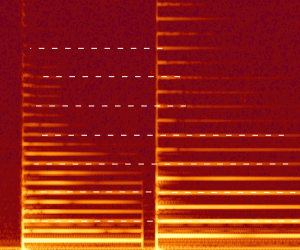Fletcher–Munson curves

The Fletcher–Munson curves are one of many sets of equal-loudness contours for the human ear, determined experimentally by Harvey Fletcher and Wilden A. Munson, and reported in a 1933 paper entitled "Loudness, its definition, measurement and calculation" in the Journal of the Acoustic Society of America.[1]
Background
The first research on the topic of how the ear hears different frequencies at different levels was conducted by Fletcher and Munson in 1933. In 1937 they created the first equal-loudness curves.[2] Until recently, it was common to see the term 'Fletcher–Munson' used to refer to equal-loudness contours generally, even though a re-determination was carried out by Robinson and Dadson in 1956, which became the basis for an ISO 226 standard.
It is now better to use the generic term "equal-loudness contours", especially as a recent survey by ISO redefined the curves in a new standard. [3]
According to the ISO report, the Robinson–Dadson results were the odd one out, differing more from the current standard than did the Fletcher Munson curves. The report states that it is fortunate that the 40-phon Fletcher–Munson curve on which the A-weighting standard was based turns out to have been in agreement with modern determinations.
The article also comments on the large differences apparent in the low-frequency region, which remain unexplained. Possible explanations are:
- The equipment used was not properly calibrated.
- The criteria used for judging equal loudness at different frequencies had differed.
- Subjects were not properly rested for days in advance, or were exposed to loud noise in traveling to the tests which tensed the tensor tympani and stapedius muscles controlling low-frequency mechanical coupling.
See also
- Robinson-Dadson curves
- Weighting filter
- CCIR (ITU) 468 Noise Weighting
- A-weighting
- Audio quality measurement
- Listener fatigue
- Mel scale
References
- ↑ Fletcher, H. and Munson, W.A. "Loudness, its definition, measurement and calculation", Journal of the Acoustic Society of America 5, 82-108 (1933).
- ↑ "Fletcher Munson Compensation". FMC. Retrieved 2016-12-02.
- ↑ ISO 226:2003
External links
- ISO Standard
- Interesting comparisons of ISO with R-D and Fletcher Munson - pdf
- Fletcher-Munson is not Robinson-Dadson - pdf
- Full Revision of International Standards for Equal-Loudness Level Contours (ISO 226)
- Hearing curves and on-line hearing test
- Equal-loudness contours by Fletcher and Munson
